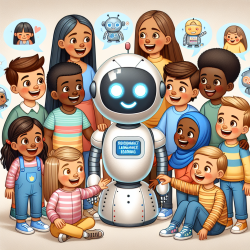In the field of speech-language pathology, data-driven decisions and evidence-based practices are paramount for achieving optimal outcomes for children, particularly those with Autism Spectrum Disorders (ASD). Recent research published in Frontiers in Robotics and AI, titled "Long-Term Personalization of an In-Home Socially Assistive Robot for Children With Autism Spectrum Disorders," provides valuable insights into the effectiveness of socially assistive robots (SAR) in supporting the developmental needs of children with ASD.
The study conducted by Clabaugh et al. (2019) investigated the use of a fully autonomous SAR system that personalizes its interactions based on each child's unique learning patterns. The hierarchical human-robot learning (hHRL) framework was employed, consisting of five controllers—disclosure, promise, instruction, feedback, and inquiry—mediated by a meta-controller utilizing reinforcement learning. This framework allowed the SAR system to adapt the level of instructional challenge and feedback to match each child's proficiency.
The study involved 17 children with ASD, aged 3-7 years, who participated in month-long interventions in their homes. The findings demonstrated that the SAR system successfully personalized its instruction and feedback over time, resulting in significant improvements in targeted skills and long-term retention of intervention content. Notably, all child participants were engaged for the majority of the intervention, and their families reported the SAR system to be useful and adaptable.
Key Takeaways for Practitioners
For practitioners looking to implement similar interventions or improve their current practices, the following points are crucial:
- Personalization is Key: The hHRL framework's ability to adapt to each child's unique learning patterns underscores the importance of personalized interventions. Practitioners should consider incorporating adaptive technologies that can tailor interactions based on individual needs.
- Long-Term Engagement: The study highlighted that long-term engagement is feasible with SAR systems. Ensuring that interventions are engaging over extended periods is critical for sustained developmental gains.
- Reinforcement Learning: The use of reinforcement learning to adjust the level of challenge and feedback was instrumental in the study's success. Practitioners should explore incorporating machine learning techniques to enhance the adaptability and effectiveness of their interventions.
- Comprehensive Data Collection: The study's robust data collection methods, including video, audio, and performance metrics, were essential for evaluating the SAR system's impact. Practitioners should implement comprehensive data collection strategies to monitor and adjust interventions as needed.
Encouraging Further Research
While the study provides compelling evidence of the benefits of SAR systems, further research is needed to explore the scalability and long-term impacts of these interventions. Practitioners are encouraged to contribute to this growing body of knowledge by conducting their own studies and sharing their findings with the broader community.
To read the original research paper, please follow this link: Long-Term Personalization of an In-Home Socially Assistive Robot for Children With Autism Spectrum Disorders.










